Weed-It Precision Sprayers
Having grown up in a farming community, I've always been amazed at the difference in technology that (agronomic) farmers use compared to nurseries and landscape ontractors. It’s like farmers are driving around in Land Rovers and us nursery and landscape folks have all our Earthly possessions piled in the back of our 1921 Oldsmobile Model 43-A touring car (a la Jed Clampett). Well, maybe not that bad, but typically our toys don’t match up with their toys.
However, I was recently at a farm equipment show and got to check out a toy that I think both nursery and landscape folks could take advantage of. It’s “smart sprayer” technology developed by Weed-It that uses light sensors to detect weeds. Once detected, the weed is sprayed, then the spray nozzle is turned off until the sensor detects another weed. So rather than a continuous spray pattern, it only spot sprays those weeds that pass under the spray boom. What’s better, the company claims it can reduce herbicide use by 90%.
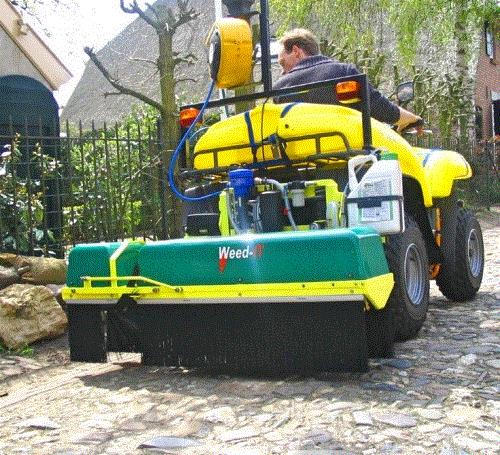 ThsT
ThsT
So the question is, who would benefit most from this tech? My first impression is that container nursery growers who are a bit OCD about weed control (which is a food thing) could use this to spot treat around container pads, treat pads between crops, and hit roadways. Landscape contractors may have a harder time justifying the purchase unless they maintain a large number of unpaved driveways (where this is commonly used). Nonetheless – it’s certainly a nifty piece of tech!

Ginko Presidential Gold
I’m a sucker for fall color and it’s hard to beat any Ginko for reliable fall color, both on the tree and on the ground as the leaves fall and create a golden picnic blanket (that’s a hint for all you single guys). Ginko is also one of those fantastic trees when it comes to pest and disease management, simply because it stands up to just about any pest and pathogen issue common to nurseries or landscapes. And name a tree that does equally well from Zone 3 to 10 (sorry, red maple fans – you can’t claim that)?
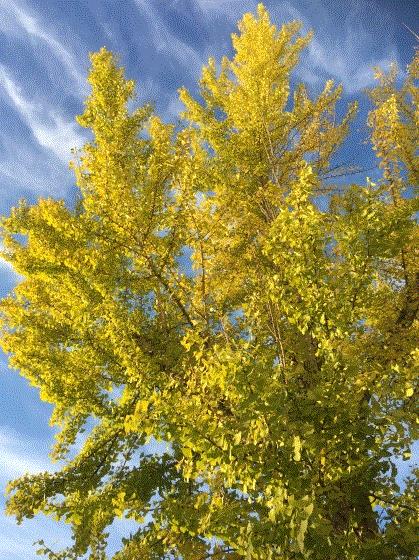
I was recently in Memphis and snapped this photo of Presidential Gold (also known as The President) in all of its fall glory. What’s nice about Presidential Gold, from a grower perspective, is its uniformity of growth rate and form. Better yet, it maintains a central leader without much effort (pruning). From the landscape perspective, it makes a great street tree (if you have the room) because the mature crown size is very uniform, albeit large with a max height of 50 ft. and a width of 30 ft. It can also handle poor soils and an above-average amount of air pollution.

Catching Up on Webinars
As the temps drop outside, my workload lessens a bit and I'm able to catch up on webinars that I missed during the frantic rush that is late summer/fall, especially considering I'm teaching and trying to button up the year. While all of the GrowerTalks webinars are good, there are a few that I really enjoyed that include:
Making “Fronds" with Foliar Fungicides (Sponsored by BASF). In this free webinar, Dr. Janna Beckerman delved into the details on a range of foliar diseases, briefly focusing on diagnosis, but more heavily emphasizing management, and also how to most effectively deploy fungicides. She also spoke about how some diseases -- namely phytophthoras, pythiums and rhizoctonias --can “jump the shark,” as she puts it, causing both root rot and aerial blights.
Best New Plants for 2018 – Part I and Best New Plants for 2018 – Part II
Follow along with Chris Beytes and Ellen Wells (aka "The Bobbleheads") as they toured the California Spring Trials. The duo shared their picks of the trials in annuals, perennials, tropicals and other categories, plus shared their winners for best of display ideas, news, novelties and things that made them go "Hmmmmm." Part 1 covered the Southern stops, which included all the Ball companies, GroLink, Dümmen Orange, Terra Nova, Floranova, Hort Couture, Florist Holland and more.The second half of Chris and Ellen's Spring Trials coverage included the best new annuals, perennials and more from the northern portion of the California Spring Trials. Varieties from the following companies are featured: Syngenta, Proven Winners, Danziger, Benary, Sakata, American Takii, Westhoff, Hem Genetics and more.

It’s A Cold, Cold Frame
I field a lot of calls this time of year regarding the use of cold frames to protect nursery stock. First, I define a cold frame as a single-layer polyethylene (plastic)-covered structure with no heat source or ventilation system (other than doors, which are manually opened).
For some reason, many people assume that because it looks like a greenhouse, it will magically keep plants warmer than if the plants were simply jammed (pot-to-pot) on a nursery pad. In reality, on any given night, temperatures inside the structure will only be 2 to 10 degrees F warmer than exterior temperatures. And it can actually be colder inside the cold frame than outside if condensate forms on the interior of the plastic and later evaporates (hence evaporative cooling). What I consider to be the largest benefit of cold frames is wind protection for broadleaf evergreens and conifers. Broadleaf evergreens, in particular, can receive foliar damage from winds while temps are below freezing. It’s actually desiccation (drought) damage, as the leaves transpire, but don’t receive any water because all water in the soil is frozen.
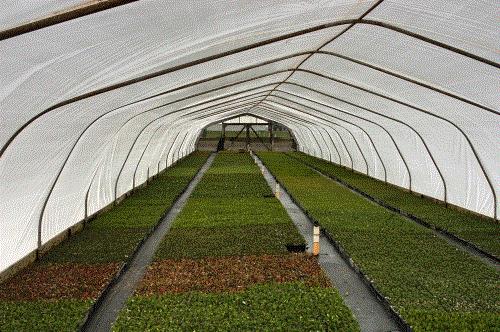
As you can see in this photo, a cold frame (this is a spring shot with the end walls removed) is a rather spartin structure, with the only infrastructure beyond the frame being irrigation.
So don’t make the mistake of thinking a cold frame will protect tender plant material. Assume the interior temps will be equal to atmospheric temperature and remember that the same rule applies to container plants in a cold frame that applies outside on a nursery pad when protecting from cold temps. Whatever hardiness zone you're in (e.g. Zone 8a), subtract two hardiness zones when that plant is in a container (Zone 6a in this case). I call this the “adjusted zone,” which you should use to make management decisions regarding winter protection.

Speaking of Cold, Cold Frames
I’m also frequently asked what are some of the biggest no-nos when it comes to cold frames. I described one above, but there are a few others that warrant a mention. So here goes:
-
Never put shade cloth on the outside of plastic in the winter. Why? Because when it snows, that snow will not shed and the result will be a collapsed cold frame. I’ve seen 2 in. of snow bring down a shade-cloth covered cold frame.
-
And if you're in an area that receives snow (especially heavy/wet snow), you need cross-bracing in cold frames. Remember, it's a cold frame, as in there's no heat, so there'll be minimal melting (and depending on the roof angle, minimal shedding) of snow that falls on a cold frame. Here in Georgia, we get a 3- to 5-in. snow about every three years and poof… collapsed cold frames everywhere. It isn’t that expensive of an insurance policy.
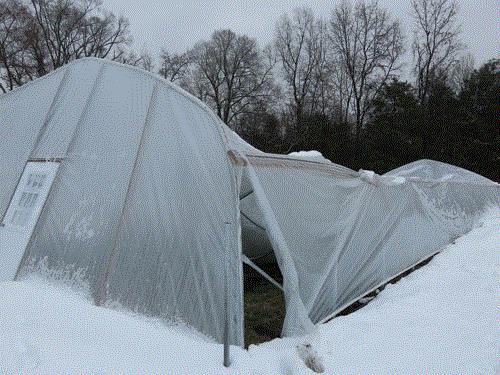
Cross-bracing structures for snow protection can save you from this agony.
C
C
-
Don’t be a tightwad on your plastic. Do your research on plastic and remember you get what you pay for. There are different thicknesses (I typically recommend 6-mil), different longevities (e.g. one-year versus three-year) and differences in flex (the amount that a plastic will stretch before ripping).
-
When opening doors, always open the downwind side first. If you open the prevailing wind side first, you're essentially creating a balloon-effect that can cause stress points where the plastic is fastened and can lead to rips.
-
Don’t leave gaps at the base of the structure. Doing so allows wind to enter under the structure and that can cause stress on the plastic. It also negates any temperature protection you may get from the structure, and especially emergency portable heaters, should they be needed in a pinch.

Traveller Redbud
It’s hard not to like redbuds (Cercis canadensis or Cercis canadensis var. texensis), especially in space-limited gardens. The cultivar Traveller (yes – with two Ls instead of one) is an outstanding cultivar of Cercis canadensis var. texensis that oddly I see very infrequently in my travels (punny, eh?).
What makes it outstanding is its durability and greater environmental tolerance compared to Cercis canadensis cultivars. A lot of that added sun tolerance and ability to perform well in dry conditions is due to the waxy cuticle on the foliage, which is evident while looking at it shine in sunlight. Oh, then there's also that weeping habit and who doesn’t want a 5- to 7-ft. weeping tree in their landscape?
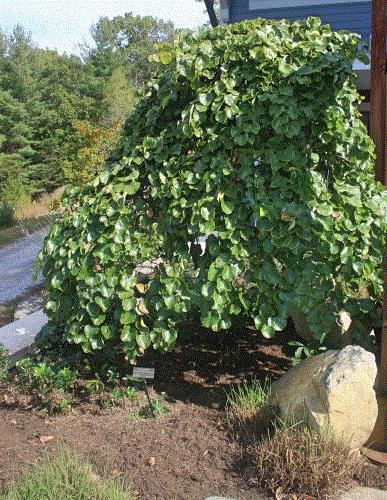
Hard to beat Traveller, especially when a focal point is needed in the garden.
Hardy to Zone 6a, it can handle full sun in the northern areas, but should be given a bit of afternoon shade down south. Otherwise foliage may begin to look a bit weathered come late August into September. A couple of other things to note about Traveller is that the flowers are a bit lighter pink compared to the species (or variety to be technical). It also doesn’t seem to set any seed, which should make the invasive species folks happy!
And for all of you landscape contractors and nursery folks out there, take note. Traveller wasn’t developed in come complicated university breeding program. It was actually discovered in a row of seed-grown trees by Dan Hosage, Jr. of Madrone Nursery in San Marcos, Texas. So keep your eyes open – you never know what you may find!

H-2B Back in the News – And AmericanHort Needs Your Input
It seems like most of the talk coming out of Washington, D.C. these days revolves around the federal budget. And while tax reform may dominate the headlines, any budget process is a golden opportunity to implement changes to a variety of programs. H-2B is one such program and Craig Regelbrugge, with the assistance of AmericanHort members, are trying to add some H-2B relief into the end-of-year spending bill.
As a co-chair of the H-2B Workforce Coalition, AmericanHort members participated in a fly-in on November 2. More than 200 H-2B users visited with their lawmakers on Capitol Hill urging immediate H-2B cap relief through the annual federal spending process, as well as permanent H-2B reform. On the same day, in conjunction with state Green Industry associations (Lighthouse grassroots partners), AmericanHort pushed out a nationwide call to action. So far, over 500 letters have been sent to Congress urging cap relief and program reform. Thanks to all who came to Washington or have contacted their elected leaders. If you haven't taken action yet, please take a moment to do so now by signing a letter to Representatives.

Our Wild and Wacky World – Notes from the Edge of Sanity
I’ll start this by apologizing to Slender Silhouette sweetgum. I, based on my observations over the years, stated that fall color on Slender Silhouette wasn’t great. But I was quickly corrected by those in the Pacific Northwest, who also managed to slide in a variety of snarky comments about how southerners have no idea what fall color even look like. So, yeah – I deserved that.
I also wanted to touch on a subject that I've mentioned before, and that almost everyone hates doing, but that's required to be successful. And no, it isn’t taxes or going to the dentist. It’s maintaining inventory data and crop-specific record keeping. Whether you're a nursery manager or landscape contractor, I can’t begin to tell you the hundreds of thousands of dollars that I’ve witnessed businesses losing due to simply not keeping good records. In fact, 13% of businesses keep no records and I have no idea how they sleep at night.
Let me give you a scenario from a grower’s perspective: Let’s assume you have a total crop failure. Again, let’s assume you know the exact cause of this crop failure - for example a greenhouse heater malfunctioned, causing ethylene gas to build up in the structure that resulted in malformed growth. Since the heater is under warranty, you sue the heater manufacturer for damages. But the heater manufacturer comes back and says, "What chemicals did you apply to the crop? What fertilizers did you apply to the crop? Do you have diagnostic reports for the crop that show no abnormalities prior to the supposed heater malfunction?"
If you have these records (and photos showing a healthy crop prior to the incident), you’re likely to be successful in a settlement. If not, then you'll be hard-pressed to win a dime, despite knowing exactly what happened. That, friends, is the ultimate in frustration, but totally the grower’s fault.
How often do such cases occur? Far more frequently than you may assume. And while keeping detailed crop records and inventory may be as much of a pain as taxes, it could be the difference in success and failure of a business. Furthermore, this is a good time of year to get in the habit of tracking inventory and keeping detailed crop records, as things are winding down (momentarily). So get on it!

Live authentic,

Matthew Chappell
Editor-at-Large
Nursery & Landscape Insider
This has been received by 29,129 of the hardest-working horticulturists in show business!
If you're interested in reaching 29,129 (and growing) clients who eagerly await every Nursery & Landscape Insider and surely read every word, contact Kim Brown ASAP and she'll hook you up. And spread the word... let's get to 30,000 readers!